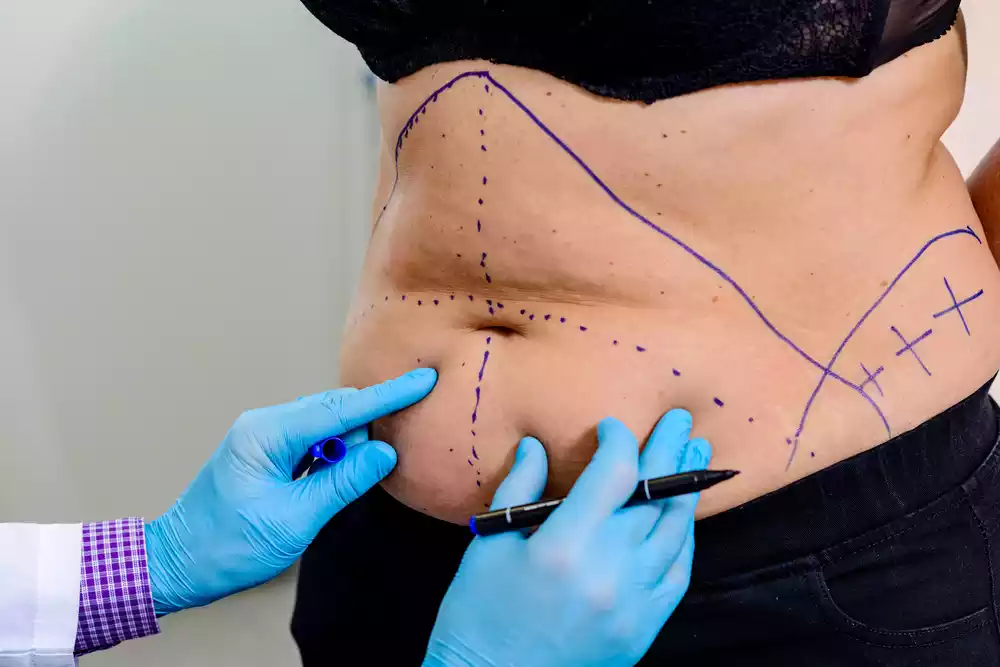When considering plastic surgery, one of the factors that both patients and surgeons take into account is Body Mass Index (BMI). This simple calculation is based on height and weight, and it categorizes individuals into different weight status categories. Although BMI does not directly measure body fat, it is commonly used as a screening tool for assessing whether a patient is at an ideal weight for surgery. Let’s delve into how BMI and plastic surgery are related, why it’s a consideration, and what it means for those planning a procedure.
Understanding BMI and plastic surgery
BMI is a numerical value derived from a person’s height and weight. It is widely used to determine a person’s weight category, assessing whether they are underweight, normal weight, overweight, or obese. In the realm of plastic surgery, BMI serves as an important metric for evaluating a patient’s suitability for various procedures.

Why BMI matters in plastic surgery
Assessing surgical candidacy
In the context of BMI and plastic surgery, BMI is commonly used to help assess whether a patient is a suitable candidate for plastic surgery. Typically, patients with a BMI below 30 are considered good candidates for plastic surgery, as they are less likely to encounter complications during and after the procedure.
Reducing risks and complications
Higher BMI levels are associated with increased risk during surgery, including complications such as infection, poor wound healing, and anesthesia-related risks. By taking BMI into account, plastic surgeons can reduce the likelihood of these complications, leading to safer procedures and quicker recovery times. In BMI and plastic surgery, the relationship between BMI and the potential for surgical complications cannot be understated.
Achieving optimal results
For procedures like body contouring and liposuction, surgeons aim for optimal aesthetic outcomes through the careful consideration of BMI and plastic surgery. A BMI within a healthy range supports better surgical results, enhancing both safety and effectiveness. Excessive body fat can interfere with achieving the desired contour, making it crucial to consider BMI and plastic surgery requirements when planning aesthetic surgeries.
Guiding Pre-Surgical preparation
In the context of BMI and plastic surgery, your BMI can guide both you and your surgeon in preparing for surgery. If your BMI is above the recommended range, your surgeon might recommend weight loss strategies to align with BMI and plastic surgery guidelines. This preparation helps achieve better results and ensures that the surgical procedure is both safe and effective.

Procedures and BMI considerations
Different plastic surgery procedures have varying requirements concerning BMI and plastic surgery needs. Here are some common procedures where BMI plays a crucial role:
Tummy Tuck (Abdominoplasty)
- Ideal BMI: Below 30
- Considerations: A higher BMI can hinder the tightening of abdominal muscles and increase risks related to anesthesia, highlighting the importance of BMI and plastic surgery guidelines.
Liposuction
- Ideal BMI: Below 30
- Considerations: Intended for contouring rather than weight loss; excess fat removal in patients with high BMI can lead to less predictable results, demonstrating the interplay between BMI and plastic surgery outcomes.
Breast Surgery (Augmentation, Reduction, Lift)
- Ideal BMI: Below 30
- Considerations: A higher BMI may affect wound healing and the aesthetic balance of breast procedures, making BMI and plastic surgery considerations critical.
Facelift
- Ideal BMI: Not as crucial as with body procedures, but excess facial fat can influence results.
- Considerations: Maintaining stable weight ensures long-term results, reinforcing the connection between BMI and plastic surgery success.

BMI and patient safety
Ensuring patient safety is the primary concern for any surgical procedure. BMI offers a framework to evaluate risks and prepare for various procedural challenges. Here’s how BMI plays into patient safety:
Anesthesia safety
BMI can influence the dosage and effectiveness of anesthesia. Higher body fat percentages can complicate anesthesia delivery, leading to potential complications during surgery.
Wound healing
Patients with higher BMIs often experience slower wound healing due to poor circulation and increased pressure at incision sites, leading to higher rates of infection and dehiscence.
Postoperative recovery
A healthier BMI can translate into a smoother and quicker recovery process. Patients with lower BMIs tend to conform to postoperative guidelines more effectively, experience fewer complications, and enjoy a more straightforward healing period.
Steps to Reach Ideal BMI for Surgery
Reaching an ideal BMI for plastic surgery involves adopting a balanced diet, engaging in regular physical activity, and fostering a healthy lifestyle. Here are some steps to help you prepare:
- Consult a nutritionist or dietitian: To develop a sustainable weight loss plan that meets your nutritional needs.
- Integrate regular exercise: Consistent physical activity aids weight management and enhances overall health.
- Seek behavioral therapy: For identifying and changing habits that lead to weight gain.
- Regular monitoring: Keep track of BMI changes and consult your surgeon for updates on your surgical candidacy.

Reducing Your BMI before surgery
Reducing your BMI (Body Mass Index) before plastic surgery is important to minimize risks and get better results. Here’s a step-by-step guide:
1. Calculate your current BMI
Formula:
{BMI} = Weight (in kg) / (Height) 2 (in m)
- 18.5: Low weight
- 18.5-24.9: Normal (ideal for surgery)
- 25-29.9: Overweight
- 30: Obesity (many surgeons require a BMI < 30 to operate), if the procedure can be up to <32
2. Goal: Achieve a BMI < 30
- If your BMI is > 30: You will need to lose weight.
- If you are between 25-30: Some surgeons can operate, but a lower BMI reduces risks.
3. Strategies to reduce your BMI
Feeding (70% of success):
- Calorie deficit: Consume fewer calories than you spend.
- Lean proteins: Chicken, fish, eggs, legumes (maintain muscle).
- Vegetables and fiber: Fill without many calories (spinach, broccoli, avocado).
- Avoid: Refined sugar, white flours, fried and processed food.
- Hydration: 2-3 liters of water per day (reduces fluid retention).
Exercise (30% of success):
- Cardio (fat burning): Fast walking, swimming, cycling (30-60 min/day).
- Strength (toning): Weights or exercises with your own weight (2-3 times/week).
- Consistency: Better 30 min daily than 2 hours only on weekends.
Sleep and stress:
- Sleep 7-8 hours: Lack of sleep increases cortisol, promoting abdominal fat.
- Manage stress: Meditation, yoga or deep breathing help to avoid eating anxiety.
4. Consult a professional
- Nutritionist: Will help you with a personalized plan.
- Plastic Surgeon: Ask for an assessment to know exactly what BMI you need to achieve.
5. Estimated time
BMI 30 → 25: It depends on your metabolism, but with discipline, in 3-6 months you can achieve (0.5-1 kg per week is healthy).
6. Keep your weight stable before and after surgery
Many surgeons ask for 3 months of stable weight to ensure no rebound. After a gastric bypass surgery, it is recommended 1 year or once the weight has been stabilized.

Risks of operating with high BMI
In the context of BMI and plastic surgery, operating with a high BMI carries several risks:
- Increased likelihood of complications: A high BMI is associated with a heightened risk of complications such as infections, poor healing, and thrombosis. These risks underscore the importance of considering BMI and plastic surgery guidelines.
- Less defined results: Excess fat can obscure the intended contour, leading to less defined results. This highlights why BMI and plastic surgery considerations are integral to achieving optimal aesthetic outcomes.
Comprehensive diet and exercise plan for effective BMI reduction
Here is a structured diet and exercise plan to reduce your BMI in a healthy and sustainable way, focused on losing fat without losing muscle.
Feeding Plan (1 Day Example)
Goal: Calorie deficit (500-700 kcal less than your daily expenditure).
Option 1 (Balanced)
- Breakfast: 2 scrambled eggs + 1 slice of whole wheat bread + avocado (1/4) + green tea.
- Mid-morning: 1 handful of almonds (10-12 pieces) + 1 apple.
- Lunch: 120g grilled chicken breast + 1 cup quinoa/brown rice + green salad (spinach, cucumber, tomato).
- Snack: 1 unsweetened Greek yogurt + 1 teaspoon of honey.
- Dinner: 100g salmon or tofu + 1 cup steamed broccoli + 1/2 sweet potato.
Option 2 (Low-carb for Increased Fat Burning)
- Breakfast: Smoothie (spinach, 1/2 banana, 1 tablespoon protein powder, almond milk).
- Mid-morning: 1 hard-boiled egg + 1 handful of cucumbers.
- Lunch: 120g lean meat + kale salad, carrot and lemon + 1/2 avocado.
- Snack: 1 handful of nuts + unsweetened infusion.
- Dinner: White egg omelet with asparagus + miso soup.
Key Rules:
- Avoid: Refined sugar, white bread, fried foods, alcohol and sugary drinks.
- Portion Control: Use your hand as a guide (protein = palm size, carbs = closed fist).
- Hydration: 2-3 liters of water/day (helps metabolize fat).

Exercise Plan (4-5 Days/Week)
Goal: Combine cardio and strength to maximize fat burning and toning.
Monday & Thursday (Strength – Home/Gym):
- Squats: 4 series x 12 repetitions.
- Push-ups (or knee push-ups): 3 sets x 10.
- Abdominal iron: 3 series x 30 seconds.
- Russian weights (or bottles with water): 3 series x 10.
Tuesday & Friday (Cardio – Fat Burning):
- Quick walk or jog: 30-40 minutes.
- Jump rope: 5 series x 1 minute.
- Burpees: 3 series x 8.
Wednesday (Flexibility/Active Rest):
- Yoga or stretching (20-30 minutes).
- Weekend: 1 day total rest + 1 day light activity (swimming, walking).
Calculation of Progress
- Measure yourself 1 time/week (same time, fasting).
- Measure circumferences (waist, hip) to see localized fat loss.
- BMI Goal: If you weigh 80 kg and measure 1.65 m BMI = 29.4. To reach BMI 25, you need to drop to 68 kg (loss of ~12 kg).

Embark on your transformation with confidence
Your journey to transformation should be informed and safe, considering all aspects of health and well-being including BMI. Realizing your aesthetic goals while ensuring optimal safety and results is paramount.
If you’re aspiring to undergo plastic surgery and want to explore how BMI and plastic surgery are related, Clinica Renueva offers unparalleled expertise. As the best option for plastic surgery in Tijuana, Clinica Renueva is committed to patient safety and exceptional results. Ready to make a change? Schedule a consultation to discuss your goals and achieve the transformation you’ve been waiting for.






